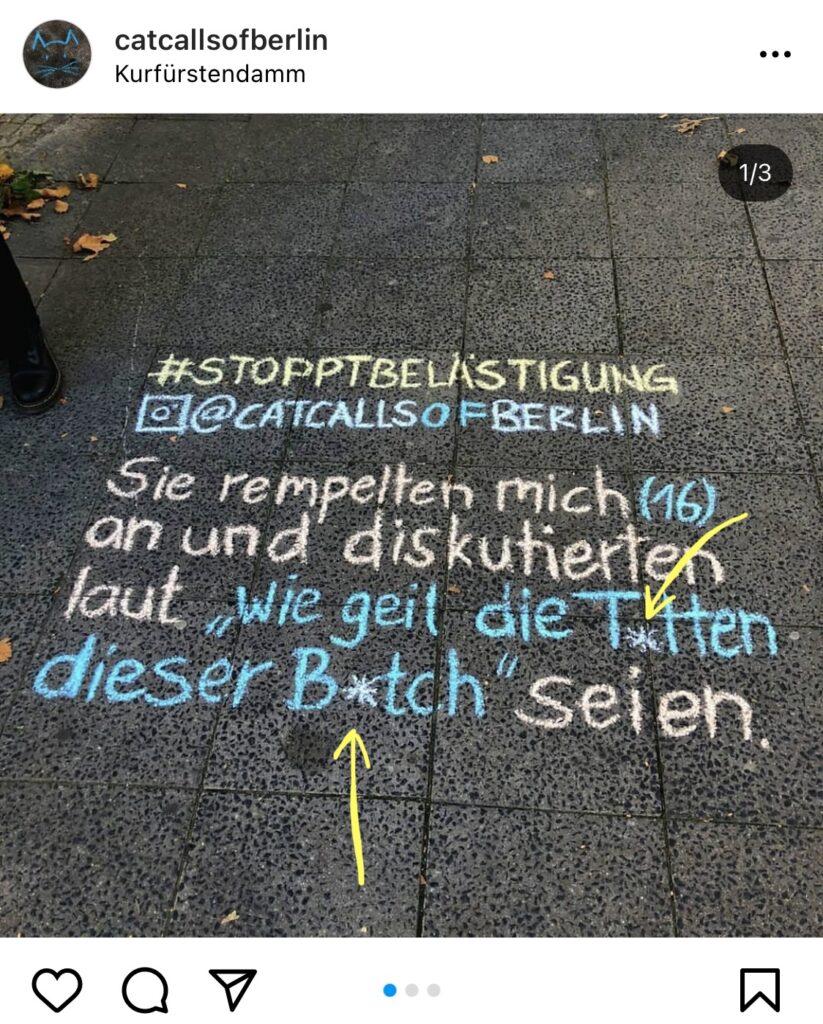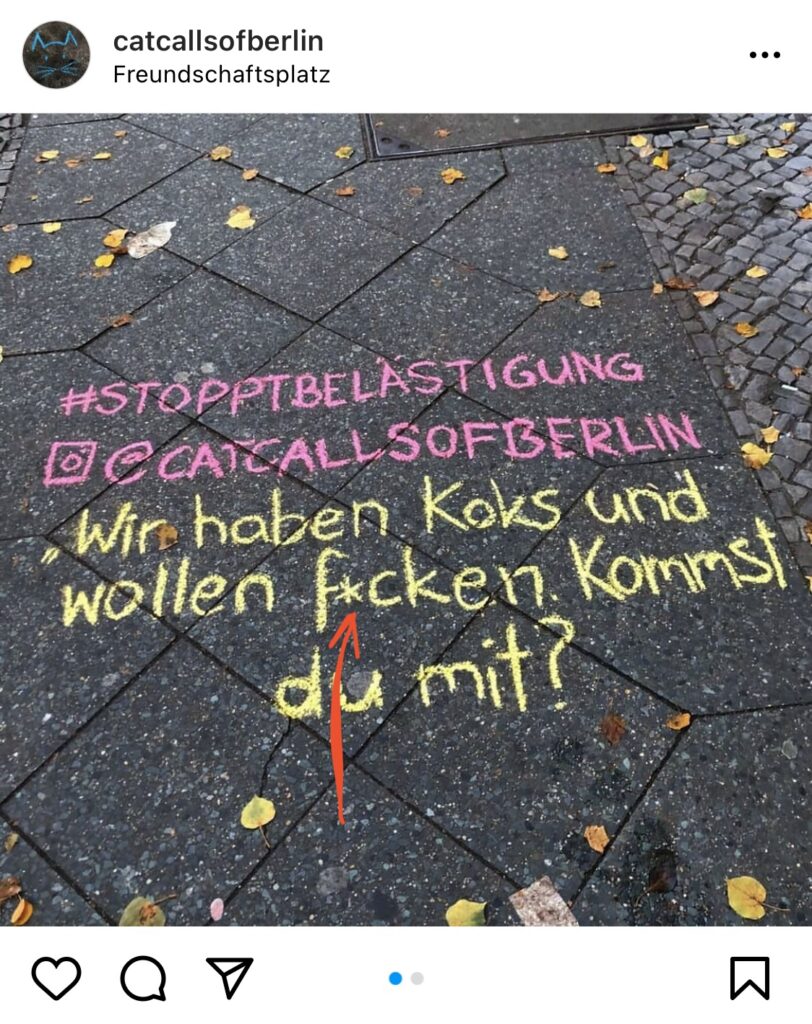Gabriela Parra Sánchez
11.01.2022
1. Introduction of “Cat calls of Berlin”:
It has been shown that social media, and mostly an app like instagram, is a wide space with questionable boundaries, in which a lot of bullying and harassment can happen, but also it can be the platform where one can report acts of hate and abuse – towards women and LGBTQ+ people, in the majority of the cases.
In November I was talking to a friend that lives in Berlin about my COMPLAINT!ivism? course, the topics we discuss about, the book we are getting our input from and the learnings I get from reading the blog. I told him about the second task and he sent me this instagram account and said: “give it a look, it might be of your interest.”
I am talking about “Cat calls of Berlin” @catcallsofberlin. Forehand I didn’t know what “catcalling” meant, it sounded like a very tender name to me for such an act.
It is “the act of shouting harassing and often sexually suggestive, threatening, or derisive comments at someone publicly”. (1) But still it was not clear enough to me why is it called catcalling?:
> “It’s called “catcalling” because it’s associated with those verses that are usually made to call cats, and bring them closer”. (2).
According to this the name of the account “Cat calls of Berlin” exposes the sexual threatens and comments that people have received in the streets of Berlin, and as they state it on their instagram biography, it is a Chalk art movement against street harassment.
It is an initiative carried out both digitally and analog on the streets from multiple cities, and its aim is to expose different harassment experiences through comments. People first share their testimonies anonymously through instagram direct messages, then the team writes a piece of the testimony on chalk nearby the place it happened and then post a photo of it, in addition to a screenshot of each testimony.
At first, even though I didn’t understand exactly what every message in every picture meant, I could imagine the heaviness of emotion every post carries. Not only because of the remembrance of that specific situation in which the victims were put into, but also because out of this exercise, victims are able to build empathy and advise others which places they were harassed in. This allow women, and everyone, to know in advance that something like that happened just right there, in that specific street, corner, whatever it was.
2. Deeper analysis of “Cat calls of Berlin” and its impact:
Although this movement was born in NYC, I wanted to focus on the Berlin’s account for some reasons:
Mainly because it is a city I frequent a lot, and even though I recognise I am in a more open and advanced culture towards the one I was born in, one may think that this type of comments or abuses are not that common in here, but through this account we can evidence that it has nothing to do with the place, its the people that provide this scenarios.
Reading these comments has reminded me the times I have been exposed to these types of comments; because of the way I was dressed, because of walking really late by my own, or even because I was talking in Spanish and just because I am latina makes them think I like to be exotized or approached in a vulgar/sensual way.
I haven’t faced such a comment in Berlin until now, but it triggers me that it can happen to me any day and I don’t know what to answer back nor how to react. Language is still a struggle to me and I will be surely shocked.
It was also sad to read many testimonies from really young girls ages 12, 13… To see how vulnerable women are still on the streets but hopefully there will always be someone that empaths with your experience and maybe they’ll make art out of it to encourage others and show they are not alone. Testimonies in the page oscillate from comments like: “Ey Puppe, willst du was machen?” “Hey sweety, do you wanna do something? (Posted on the 20.10.2021)”, to “Den Arsch will ich an mir spüren” “I want to feel that ass on me” (Posted on the 07.06.2019).
On one side, in these cases the victims are attacked by people they might have never seen before or even won’t see anymore. On the other side, the testimonies that appear in Ahmed’s book “Complaint” the victims and aggressors had already stablished- relationships such as: professor-to-student, boss-to-worker and so on. Which, I reiterate, does not make the experiences any more or less valid, nor traumatic, it is just a comparison to show that no matter the level of relation towards another person, if there is no consent, it is abuse.
In addition, by analyzing some aspects of this movement (which I really value and admire), I realized that the messages are written in chalk on the streets and as is know chalk can be easily erased by rubbing on it, or with the rain as it’s exposed to an open environment. It is not a material that permits that the message stays for a long time or even permanently; though the damages and the trauma are already permanent.
The purpose of the movement is to commemorate this situation even if it is not done justice in its totality, since its purpose is more to condemn this type of events and in a certain way to mortalize these acts in the space in which they were carried out, showing support for the victims. It is not their obligation to make this ‘art’ permanent, but I wonder if the reason for is to be written on chalk has to do with a fear against banning or another type of reason that won’t allow this to continue.
Of course to read this on the streets causes uncomfortableness to the eye and the dignity, but it is necessary to spread the word and the fact that it happens. Perhaps not to everybody, perhaps just to the unlucky ones, just to some unlucky cats.
Furthermore, I noted also that not all messages are written explicitly. It may be due to a restriction given from instagram under its terms in order to make the post available for everyone, or even for keeping respect on the streets, as children may read them. Which also concerns me in a way, because abusers do not have any type of respect while
doing this type of comments and they are always very explicit; but when one gets the chance to expose and denounce it, it has to be narrowed for it to be reached. In a sense, the abuser has freedom, while the victim must restrain herself/themselves.
Here I show two examples of what just was mentioned:
Posted on the 19.12.2021

Posted on the 04.01.2022

3. Conclusions and perspective after this exercise:
These types of initiatives on social media permit the spreading of warnings towards scenarios of this kind (like the ones we were able to read along the lines of “Complaint” by Sara Ahmed), as it instantly catches the eye of the pedestrians and will leave a temporary mark on the space due to the unfortunate events that happened right there. Still, the experienced harassment from the victims will never be fully portrayed and the abusers are not being loudly called nor exposed. Even though abuse happens both indoors or outdoors, in both cases one feels trapped, in presence or in absence of walls.
The “catcalling” is normalized in many specific cliché scenarios: out of a bar, near constructions, mostly near men-crowded places. But this exercise shows that it happens anywhere. There is no guarantee that one can come back home without receiving one catcall in the same day, nor even measure of the types of comments: it does not matter to the abuser if you are a 14, 18 or 25-year-old. They are going to act that manner anyways. There is no respect at all.
“Cat calls of Berlin” contributes to the exposure of harassment and abuse event but still it is not enough because abusers are not exposed fully. You are not given a name, nor a face. It may be an interesting outcome for the followers to be able to give a face to every executer of this disrespectful comments. Probably, it can warn the audience in a more direct way and perhaps it is someone you may know: it can be your neighbour, your teacher, your relative.
———
Invitation:
The movement has surpassed borders and it is possible to find accounts for multiple cities; including: New York, Boston, Brighton, Buenos Aires, Brussels, Rio de Janeiro, etc; and in Germany: Weimar, Bielefel, Bayreuth, Bonn, Bochum, Bamberg among others.
To visit their instagram page: https://www.instagram.com/catcallsofberlin/
To visit their twitter page: https://twitter.com/catcallsberlin
Website of the organisation behind this initiative: https://www.chalkback.org
———
References
1. https://www.merriam-webster.com/dictionary/catcalling
2. https://www.nssgclub.com/en/pills/25878/catcalling-instagram
2 replies on ““Cat calls of Berlin”, the “Chalk art movement against street harassment””
I´m totally agree about your words:
“I realized that the messages are written in chalk on the streets and as is know chalk can be easily erased by rubbing on it, or with the rain as it’s exposed to an open environment. It is not a material that permits that the message stays for a long time or even permanently; though the damages and the trauma are already permanent.”
In fact, I have found pink oil spray paint very powerful and evocative in many parts of the world, and especially in Mexico City in recent years. In a following post I will talk about the powerful feminist demonstrations and their strength in the public space in recent years in Mexico City.
Thank you.
Hi Victor! thanks for reading my post 🙂
interesting to know that some demonstrations are done in permanent materials, to enforce the idea of the unremovable trauma these abuses cause.
Emocionada por leer tu próximo post!